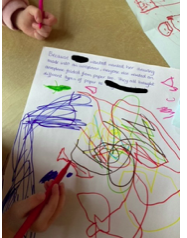Documenting Learning in a Floorbook

A blog by Avril Dante
I have been using floorbooks to document learning for a good few years and my practice has developed and changed, however, taking the children’s interests as the starting point has always been the fundamental point. I have always tried hard to document the progression in learning rather than using the floorbook as a journal – and I can’t say I’ve always been successful in that point, so when I saw a training session available for this very topic, I was on it like a seagull on chips!!!
I applied, got a place and was fortunate to attend two Zoom trainings with the inspiring and renowned Deirdre Grogan from Strathclyde University which had a focus on ‘Driving Documentation Forward’.
Deirdre looks at documentation in three phases and we need to recognise, organise, support and document children’s learning using these three phases.
Phase 1: Finding the threads (noticing and observing)
Phase 2: Sewing the threads together (evidencing and interpreting)
Phase 3: Reflecting on the threads (analysing and reflecting)
She led us through these phases, with a clear focus the whole way through on children’s thinking and the progression and depth in their thinking. (She encouraged us to use the word THINKING for learning).
I was about to start a block of work with Hurlford and Crookedholm Early Learning and Childcare Services, so, armed and confident in my own learning and understanding, (and after a conversation with the establishment manager) I planned to put into implementation the Phases of Documentation with my brilliant bubble partner Angela and the engaging children in Bubble 2. The Centre currently uses Planning in the Moment in Floorbooks, so this was a great opportunity to drive our documentation forward.
I kid you not, on day one the children provided me with an exciting new thread- I barely had to find it;
Phase 1: Finding the threads…Paper Aeroplanes
One child had penned a drawing, which was interesting in its own right, but she then asked Angela and I to make it into a plane. Before we knew it we had a queue of children pushing a piece of paper in front of us. After lots of conversation about how to fold and bring in corners to the middle and secure the integrity of the model with tape, there were planes flying everywhere – even out of the window!!! And so our mini story began…

Phase 2: Sewing the threads together

Bringing the floorbook to the table in this playroom guarantees an immediate rush to get it open with most of the children really keen to be part of the chat and mark making.
Here you can see the conversations that we had while making the planes, the questions and wonderings that the children posed and how we, as skilled practitioners, supported them to try out their thinking and talk about what had been happening.
The squiggles represent the flight paths that the planes took in the playroom. At one point, a plane flew out the open window to the outdoor area, which gave rise to more wonderings about what might be different when we take them outside…. we were progressing thinking with that question.
The children’s input is purposeful and they understand that we are telling the story of their learning. This happens because of the meaningful involvement and ownership of the floorbook; the book includes mark making, photos, drawings, scripted conversations and annotations.
We use a photograph or two to give the children a starting point. On this page we were recording what had happened when we took our planes to the field the day before. The children had made some predictions but the weather had been really windy and that gave the children a chance to think about whether that was helpful to flying our wee planes or not. They all had their own opinion about that!

Phase 3: Reflecting on the threads – bringing the thinking to a close, tying it up
In the morning, I printed out a photograph in A4 from when we had been at the field. I was able to ask the children open questions that encouraged them to think about their experiences the day before, and come to some conclusions about what they now know about paper aeroplanes. These turned out to be really logical thoughts, and at the same time gave way to the understanding of variables.
Deirdre Grogan tells us that it is hard for the children to answer the question ‘how would you do things differently? especially young children, so I was delighted that they were able to recognise what made flying their planes more difficult. It was up to Angela and I to support their thinking around what could have made the planes stronger, bearing in mind our own limited aeronautical knowledge and inability to change the weather!
It became obvious which learning experiences and outcomes we had introduced and developed throughout this mini story, and these were easily added into the documentation.

As practitioners, we are skilled at considering PLODS (possible lines of development or next steps). Deirdre Grogan encourages us to think of this as PROGRESSION in learning and thinking. DEPTH will come from using this thinking in other aspects. The children here are interested in how birds fly (or don’t fly in the case of penguins) and even since this phase of documentation, have revisited to think about different ways of flying… another thread for us now to bring together.

